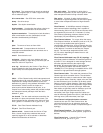input/output (I/O). Data that is provided to a computer
or data that results from computer processing.
insertion guide. On the surface of the IBM LTO
Ultrium Tape Cartridge, a large, notched area that
prevents you from inserting the cartridge incorrectly.
install. (1) To set up for use or service. (2) The act of
adding a product, feature, or function to a server or
device either by a singular change or by the addition of
multiple components or devices.
Internet. The worldwide collection of interconnected
networks that use the Internet suite of protocols and
permit public access.
interposer. An adapter-like device that allows a
connector of one size and style to connect to a mating
connector of a different size and style. Data provided to
the computer or data resulting from computer
processing.
I/O. See input/output.
J
J2 connector. Located at the rear of the Ultrium 2
Tape Drive, the connector for the LDI (or RS-422)
interface.
J33 connector. Located at the rear of the Ultrium 2
Tape Drive, a single connector that contains the
connections for the SCSI signals and grounds, SCSI ID,
SCSI bus termination, and drive power.
jumper. (1) A tiny connector that fits over a pair of
protruding pins in a connector. A jumper can be moved
to change electrical connectors. When in place, the
jumper connects the pins electrically. (2) To place a
jumper on a connector pin.
L
label. A slip of paper with an adhesive backing that
can be written on and affixed to a tape cartridge as a
means of identification or description.
label area. On the LTO Ultrium Tape Cartridge, a
recessed area next to the write-protect switch where a
bar code label must be affixed.
LAN. See local area network.
LDI. See Library/Drive Interface.
leader-pin block. Located within the Ultrium 2 Tape
Drive, the part that engages the steel pin which is
attached to the tape in an LTO Ultrium Tape Cartridge.
Once engaged, the leader-pin block pulls the tape from
the cartridge into the drive.
leader pin. On the LTO Ultrium Tape Cartridge, a
small metal column that is attached to the end of the
magnetic tape. During tape processing the leader pin is
grasped by a threading mechanism, which pulls the pin
and the tape out of the cartridge, across the drive head,
and onto a takeup reel. The head can then read or write
data from or to the tape.
LED. See light-emitting diode.
Library/Drive Interface. An electrical interface
standard that is approved by the Electronic Industries
Association (EIA) for connecting serial devices.
Library/Drive Interface (LDI) connector. Located at
the rear of the Ultrium 2 Tape Drive, the connector to
which the internal LDI cable of an enclosure connects.
The connection enables serial devices to communicate
with the drive.
LID. See loop identifier.
LID/status connector. See loop identifier (LID)/status
connector.
link services. The speed and topology of your Fibre
Channel drive. If you choose not to alter the link
services, the drive defaults to a negotiated speed and
operation in an FC-AL topology with a direct connection
to the server.
LIP. See loop initialization protocol.
light-emitting diode (LED). A semiconductor diode
that emits light when subjected to an applied voltage
and that is used in an electronic display.
Linear Tape-Open (LTO). A type of tape storage
technology developed by the IBM Corporation,
Hewlett-Packard, and Seagate. LTO technology is an
“open format” technology, which means that its users
have multiple sources of product and media. The “open”
nature of LTO technology enables compatibility between
different vendors’ offerings by ensuring that vendors
comply with verification standards.
load. Following the insertion of a tape cartridge into
the tape load compartment, the act of positioning the
tape (performed by the tape drive) for reading or writing
by the drive’s head.
load and unload cycle. The act of inserting a
cartridge into a tape drive, loading the tape to load
point, rewinding the tape into the cartridge, and ejecting
the cartridge from the drive.
local area network (LAN). A computer network that is
located on a user’s premises within a limited
geographical area. The network consists of a set of
devices that are connected to one another for
communication and that can be connected to a larger
network. Communications are limited to a
Glossary 109


















